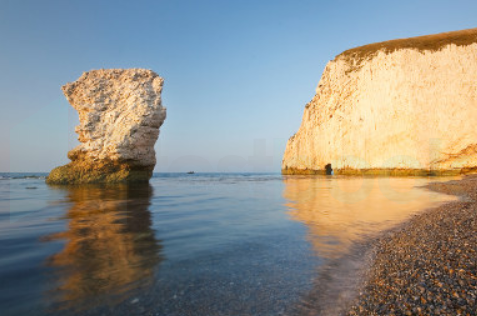Geography MCQ Quiz - Objective Question with Answer for Geography - Download Free PDF
Last updated on Dec 5, 2023
Latest Geography MCQ Objective Questions
Geography Question 1:
Which among the following landform have sword like or sharp crested form?
Answer (Detailed Solution Below)
Geography Question 1 Detailed Solution
Seif dune is a landform that has a sword-like or sharp-crested form.

Seif dune:
- Large, sharp-crested, elongated, longitudinal (linear) dune or chain of sand dunes, oriented parallel to the prevailing wind direction.
- It consists of a succession of curved slip faces produced by strong, but infrequent crosswinds.
- Seif dunes are linear (or slightly sinuous) dunes with two slip faces which make them sharp-crested
- Seif dunes are associated with bidirectional winds
- The long axes and ridges of these dunes extend along the resultant direction of sand movement
- The two slip faces make them sharp-crested.
- They are called seif dunes after the Arabic word for "sword".
- They may be more than 160 kilometers (100 miles) long,
- Seif dunes are common in the Sahara.
- They range up to 300 m (980 ft) in height and 300 km (190 mi) in length.

Geography Question 2:
Which is not a natural ecosystem?
Answer (Detailed Solution Below)
Geography Question 2 Detailed Solution
Natural ecosystem refers to the community of living and non-living things that interact and live together.
 Important Points
Important Points
- The natural ecosystem is formed naturally without and human intervention.
- An ecosystem differs from each other in size.
- A pond is a great example of a small ecosystem, a forest is an example of a medium ecosystem and a tropical rainforest is an example of a large ecosystem.
- Each ecosystem has its own climate, soil, plants, and animals.
- Ponds, forests, grasslands, deserts, mangroves, lakes, and coral are some of the natural ecosystems.
- Terrariums and aquariums are some of the artificial ecosystems.
- Artificial ecosystems are formed by human beings.
Hence, an aquarium is not a natural ecosystem.
Geography Question 3:
Which of the following is NOT a branch of Social Geography?
Answer (Detailed Solution Below)
Geography Question 3 Detailed Solution
The correct answer is Agricultural geography.
 Key Points
Key Points
Social Geography
- The most important branches of Social Science are Anthropology, Economics, Politics, Psychology, Sociology, History, Law, Linguistics, Archaeology and Geography.
- Social Science is not a common discipline of Science which requires you to bury your mind with endless scientific formulas and tire yourself out in mind-boggling experiments
- It delves deeper into the science of humankind and society and explores many branches such as Law, Political Science, Psychology, History and more.
Let’s dig more into the details of this subject through this detailed blog about branches of Social Sciences.
- Anthropology: The Study of People, Past and Present
- History: The Study of Human History
- Archaeology: The study of the human past through recovery and analysis of material culture
- Human Geography: The study of relationship between people and places
- Economics: The study of production, distribution, and consumption of goods and services
- Law: The study of legal systems in different aspects from people to businesses and environment
- Development Studies: The study of evolution of countries from socio-economic, cultural, political and geographical perspectives
- Philosophy: The study of the nature of existence
- International Relations: The study of relationships between nations and cultures
- Linguistics: The scientific study of language
- Cultural Studies: The study of diverse cultures
- Sociology: The study of human society, relationships and social change
- Psychology: The study of human mind and behaviour
- Political Science: The study of political systems and governments
- Medical geography: uses the concepts and paradigms of the discipline of geography to investigate human–environmental relationships of disease, nutrition, and medical care systems, of which maps and geographic information science (GIScience) are arguably most prominent today.
Agricultural geography
- It is defined as the study of the geographical and locational attributes, patterns, and processes of crop and animal farming, and related subjects such as farm land, farm-associated human geographers, environmental issues, and theoretical works on the location of agricultural activities.
- Agricultural geography is a sub-discipline of human geography concerned with the spatial relationships found between agriculture and humans. Hence, option 4 is not correct.
- That is, the study of the phenomenons and effects that lead to the formation of the earth's top surface, in different regions.
Geography Question 4:
Which of the following is not a component of biosphere?
Answer (Detailed Solution Below)
Geography Question 4 Detailed Solution
Biosphere refers to the narrow zone between the lithosphere, atmosphere, and hydrosphere where life exists.
 Important Points
Important Points
- The biosphere consists of living organisms both plants and animals.
- Here, the physical environment(lithosphere, atmosphere, and hydrosphere) interacts with each other and supports life.
- In the biosphere, everything is interconnected and interdependent on each other.
- Humans are dependent on plants and animals for food, minerals, etc while animals are dependent on forests and grasslands for food.
- Animals and insects like tigers and mosquitos are living beings and plants are all the components of the biosphere.
- Whereas, the soil is a non-living thing. It is required to support the life system in the biosphere.
Hence, the soil is not a component of the biosphere.
Geography Question 5:
The Earth without rotational movement would result into
A) No Sun-rise and Sun-set
B) No occurrence of day and night cycle
C) Only one season
Select the correct answer using the codes given below:
Answer (Detailed Solution Below)
Geography Question 5 Detailed Solution
Rotation refers to the daily movement of the Earth on its axis.
 Important Points
Important Points
- The rotation of the earth causes day and night.
- During the rotation, the part of the earth that faces the sun experiences day, and the other part of the earth that is devoid of the sunlight experiences night.
- The earth rotates anti-clockwise from west to east.
- The east experiences sunrise earlier than the west.
- One complete rotation takes 24 hours.
We can conclude that without the rotational motion of the earth, there will be no sunrise and sunset and there will be no day and night.
 Additional Information
Additional Information
- Further, the earth's rotation causes tidal waves.
-
It also affects the winds and ocean currents.
Top Geography MCQ Objective Questions
Earth’s core is mainly made up of ______.
Answer (Detailed Solution Below)
Geography Question 6 Detailed Solution
Download Solution PDFThe correct answer is nickel and iron.
 Key Points
Key Points
Core:
- The innermost layer is the core with a radius of about 3500 km.
- The central core has a very high temperature and pressure.
- The inner core (1200 km) is in the solid state whereas the outer core (2300 km) is in the liquid state.
- The innermost layer is the core with a radius of about 3500 km and divided into Inner and Outer core.
- The inner core is with a radius of 350 km mainly made up of- nickel and iron. The innermost layer is also called ‘nife’ (ni - nickel and fe - ferrous- iron).
 Additional Information
Additional Information
The Earth is divided into four main layers: the solid crust on the outside, the mantle, the outer core, and the inner core.
- All those layers are separated from each other through a transition zone.
- These transition zones are called discontinuities.
- Conrad Discontinuity: It lies between the Upper crust and Lower crust.
- Mohorovicic Discontinuity: It lies between crust and mantle.
- Repiti Discontinuity: It lies between the Upper mantle and Lower mantle.
- Gutenberg Discontinuity: It lies between core and mantle.
- Lehman Discontinuity: It lies between the upper core and lower core.
Interior of the Earth:
Crust:
- The uppermost layer over the earth’s surface is called the crust.
- It is the thinnest of all the layers.
- on the continental masses, It is about 35 km and on the ocean floors, only 5 km.
- The crust is the thinnest layer of the Earth and it amounts to less than 1% of our planet's volume.
- The earth is made up of several concentric layers with one inside another, just like an onion.
- The crust is the outermost layer of Earth and is made up of igneous, metamorphic, and sedimentary rocks.
- The Earth's crust is unstable because of the exogenic forces.
Mantle:
- The Mantle extends up to a depth of 2900 km below the crust.
- It is the widest section of the Earth.
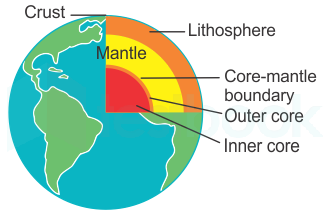
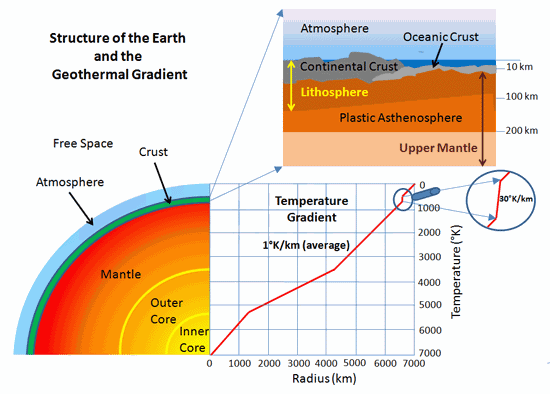
Which of the following is the closest layer to the Earth's surface in which all weather occurs?
Answer (Detailed Solution Below)
Geography Question 7 Detailed Solution
Download Solution PDFThe correct answer is Troposphere.
 Key Points
Key Points
- The troposphere is the lowest part of the Earth's atmosphere in which all tropical changes take place.
- It contains about 75% of the total air in the atmosphere.
- Based on temperature variation, our atmosphere can be classified into the following layers mainly.
- Troposphere: From Earth's surface up to 10km. Here, temperature decreases with increasing height. We, humans, live in the troposphere, and nearly all weather occurs in this lowest layer. Most clouds appear here.
- Stratosphere: From 10km above the surface to 50km above the surface, Here, temperature increases with increasing height due to the presence of the ozone layer.
- Ozone gas is capable of absorbing harmful UV rays and due to the absorption, the temperature increases.
- All the airplanes fly in this zone as due to high temperature there is less turbulence and hence smoother flights are possible.
- Mesosphere: From 50km above the surface to 85 km above the surface. Here, the temperature again decreases with increasing height. Most meteors burn up in the mesosphere.
- Ionosphere: Beyond 85km there is a thermosphere layer and Ionosphere is a series of regions in parts of the mesosphere and thermosphere.
Which one of the following scholars coined the term ‘Geography’?
Answer (Detailed Solution Below)
Geography Question 8 Detailed Solution
Download Solution PDFThe correct answer is Erathosthenese.
 Key Points
Key Points
- The term ‘Geography’ was first coined by Eratosthenes.
- It is the combination of two Greek words, Geo (the earth) and Graphos (to write).
- Geography is the study of the Earth’s landscapes, peoples, places and environments.
- Physical Geography is the study of natural things like Volcanoes, earthquakes; rivers, oceans, glaciers; soil, water, air; weather and climate etc.
- Human Geography is the study of people, settlements, transport, industry etc.
- It examines how humans adapt themselves to the land and to other people, and in macroscopic transformations, they enact on the world.
- Environmental Geography is the combination of Physical and Human geography.


 Additional Information
Additional Information
- Herodotus: Herodotus is known as the “Father of History.” and is well known for his historical accounts.
- Galileo: He was an Italian scientist and scholar whose inventions included the telescope.
- His discoveries laid the foundation for modern physics and astronomy.
- Aristotle: He was an Ancient Greek philosopher and scientist and his works are in fields of politics, psychology and ethics.
Which one of the following disciplines attempts temporal synthesis?
Answer (Detailed Solution Below)
Geography Question 9 Detailed Solution
Download Solution PDFcorrect answer is History.The
 Key Points
Key Points
- Temporal synthesis is defined as the automated construction of a system whereby we develop a temporary specification and then try to prove it.
- It is done in history as a discipline.
- It refers to the comparisons made with respect to the passage of time.
- Here, if a process is temporally extended, it means that it happens over a period of time.
- If the occurrence of two events differs temporally, then they happened at different points in time.
 Additional Information
Additional Information
- Spatial synthesis is attempted by Geography.
- It includes any of the formal techniques which study entities using their topological, geometric, or geographic properties.
Which is the most suitable cash crop for black soil?
A. Cotton
B. Tea
C. Jute
D. Oilseeds
Answer (Detailed Solution Below)
Geography Question 10 Detailed Solution
Download Solution PDFThe correct answer is Cotton.
- Cotton is the most suitable cash crop for black soil.
- The largest producer of cotton in India is Maharashtra followed by Gujarat and Telangana.
- The largest producer of cotton in the world is India followed by China and the United States of America (USA).
- The cash crop is also known as profit crop is an agricultural crop that is grown to sell for profit.
- Some examples of cash crops are tea, coffee, rubber, coconut, and spices.
- Black soil which is found in India is rich in metals such as Aluminium, Magnesium, Lime, Calcium, and Iron.
- It is deficient in Phosphorous, Potassium, Nitrogen, and organic matter.
- The black soil is also called regur and black cotton soils because cotton is the most important crop grown on these soils.
- This soil is mainly found in Tamil Nadu, Maharashtra, Gujarat, Madya Pradesh, Andhra Pradesh, and parts of Karnataka.
- It has the highest water-retaining capacity.
- The texture of the black soil is Clayey.
Image of Cotton:

Consider the following statements and identify the layer of the atmosphere:
A. This layer is free from clouds.
B. This layer is ideal for flying airplanes.
C. It contains a layer of ozone gas.
Answer (Detailed Solution Below)
Geography Question 11 Detailed Solution
Download Solution PDFThe atmosphere around the earth:
- The atmosphere consists of different layers with varying densities and temperatures.
- The column of the atmosphere is divided into five different layers depending upon the temperature condition.
- They are troposphere, stratosphere, mesosphere, thermosphere, and exosphere.

Stratosphere:
- It is suitable for flying aircraft because this layer is almost free from weather disturbances.
- It extends from tropopause up to 50 km of height.
- It is an extremely dry region and almost no clouds are present in it except cirrus and mother of pearl clouds.
- The ozone layer is found in this layer.
- The ozone layer absorbs UV rays and safeguards the earth from harmful radiation.
Thus, it is clear that the statements describe the Stratosphere.
 Key Points
Key Points
- Troposphere:
- It is the lowermost and the most important layer of the atmosphere, as almost all the weather phenomena occur in this layer.
- It extends from the earth's surface up to 8 km over the pole and 18 km over the equator it means, the troposphere is thick over the equator than over the pole. the first 1.5 to 2 km height of the troposphere is called the friction layer.
- The troposphere is not suitable for flying aircraft, because bumpy air pockets are present in this layer.
- Mesosphere:
- It extends from 50 km to 80 km in height.
- In this layer, temperature decreases with height, and at the end of this layer, temperature becomes -100°C, which is the minimum temperature of the atmosphere.
- Thermosphere:
- It extends from 80 km to 400 km in height and it is the thickest among above all layers.
- In this layer, most of the gases are present in an ionized state and electrical conductivity is responsible for reflecting the radio waves and other electromagnetic waves back to the earth's surface.
The total length of India’s coastline is
Answer (Detailed Solution Below)
Geography Question 12 Detailed Solution
Download Solution PDFThe correct answer is 7516.6 kms.
 Key Points
Key Points
- Coastline of India
- The peninsular part of India extends towards the Indian Ocean.
- This has provided the country with a coastline of 6,100km on the mainland.
- The total length of the coastline of the mainland, Lakshadweep Islands, and Andaman & Nicobar Islands are 7,516.6 km.
- India's coastline extends to Nine states (Gujarat, Maharashtra, Goa, Karnataka, Kerala, Tamil Nadu, Andhra Pradesh, Odisha, and West Bengal) and four Union Territories (Puducherry, Lakshadweep, Daman & Diu, and Andaman & Nicobar Islands).
- Gujarat has the largest share (23%) in India's coastline, followed by Andhra Pradesh and Tamil Nadu.
 Additional Information
Additional Information
| State | Coastline (in km) |
| Gujarat | 1214.70 |
| Andhra Pradesh | 973.70 |
| Tamil Nadu | 906.70 |
| Maharashtra | 652.60 |
| Kerala | 569.70 |
| Odisha | 476.70 |
| Karnataka | 280 |
| Goa | 101 |
| Andaman Nicobar | 1912 |
Which of the following is NOT a desert in India?
Answer (Detailed Solution Below)
Geography Question 13 Detailed Solution
Download Solution PDFThe correct answer is the Indus valley desert.
 Key Points
Key Points
- The Indus Valley Desert is an almost uninhabited desert ecoregion of northern Pakistan.
- It covers an area of 19,501 sq km in northwestern Punjab Province between the Chenab and Indus rivers.
- It is drier and less hospitable than the northwestern thorn scrub forests that surround it with temperatures ranging from freezing in winter to extremely hot in summer with only 600-800 mm of rainfall per year.
- The desert is home to five large mammals: Indian wolf, striped hyena, caracal, Indian leopard, and the urial along with many rodents and other mammals.
 Additional Information
Additional Information
- The Thar desert
- The Thar Desert is located in India (Rajasthan) and is also known as the Great Indian Desert.
- The Thar Desert extends between the Aravalli Hills in the northeast and the Rann of Kutch in the west and the alluvial plains of the Indus River in the northwest.
- It is located partly in the Rajasthan state of India and partly in the Punjab and Sindh provinces of Pakistan.
- Rann of Kutch
- The Great Rann of Kutch is a salt marsh in the Thar Desert in the Kutch District of Gujarat.
- It is divided into the Great Rann and Little Rann.
- The history of the Rann of Kutch began with early neolithic settlements. It was later inhabited by the Indus Valley Civilization as well as the Maurya and Gupta empires of India.
- Spiti valley cold desert
- Spiti Valley is a cold desert mountain valley located high in the Himalayas in the northeastern part of the northern Indian state of Himachal Pradesh.
- The name "Spiti" means "The middle land" i.e. the land between Tibet and India.
Which of the following is the outermost layer of the atmosphere?
Answer (Detailed Solution Below)
Geography Question 14 Detailed Solution
Download Solution PDFThe correct answer is Mesosphere.
 Key Points
Key Points
- The mesosphere is the outermost layer of the atmosphere among these all options.
- Among all layers of the earth's atmosphere Exosphere is the outermost layer.
- The mesosphere is the third layer of the atmosphere, directly above the stratosphere and directly below the thermosphere.
- In the mesosphere, temperature decreases as altitude increases.
Image: 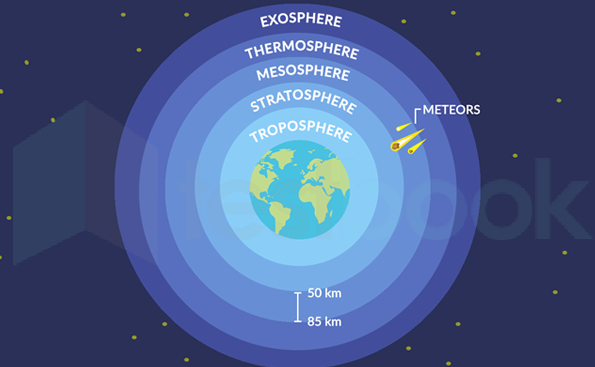
 Important Points
Important Points
- The Ozone layer is in Stratosphere.
- Planes generally fly in Stratosphere.
- The stratosphere is about 5 kilometres from the ground.
 Additional Information
Additional Information
- The asthenosphere is the highly viscous, mechanically weak, and ductile region of the upper mantle of Earth.
- The lithosphere is the rocky outer part of the Earth.
- The troposphere is the bottom-most layer of the Earth's atmosphere.
Which landform is produced by wind erosion?
Answer (Detailed Solution Below)
Geography Question 15 Detailed Solution
Download Solution PDFThe correct answer is Zeugen.
 Key Points
Key Points
- Zeugen landform is produced by wind erosion.
- Zeugen:
- It is table shaped landform.
- Mostly seen in arid and semi-arid regions.
- The softer part of the rock is eroded by wind and the harder part remains as it is.
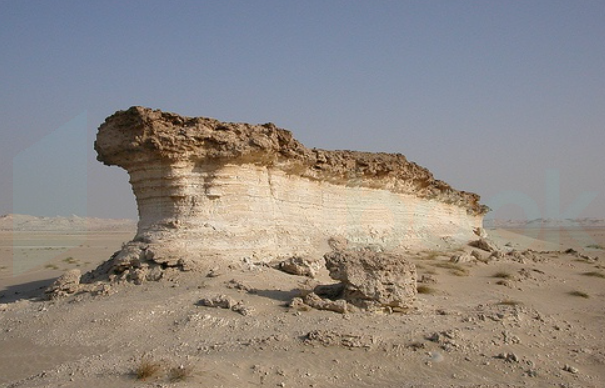
 Additional Information
Additional Information
- Cirque:
- Cirques are formed by glacier erosion.
- Cirques are amphitheater-shaped valleys with precipitous walls.
- Stacks:
- Stacks are formed by coastal wind and water waves.
- Generally seen in coastal areas.
- The formation of Stacks takes a very long time.
